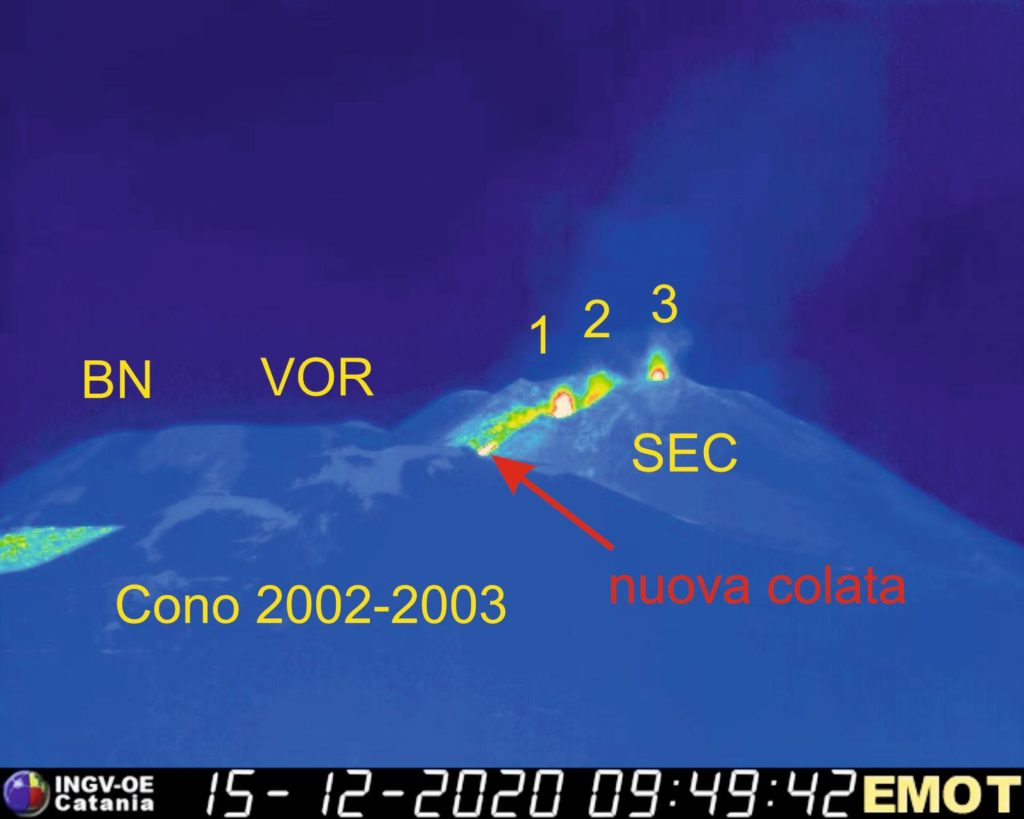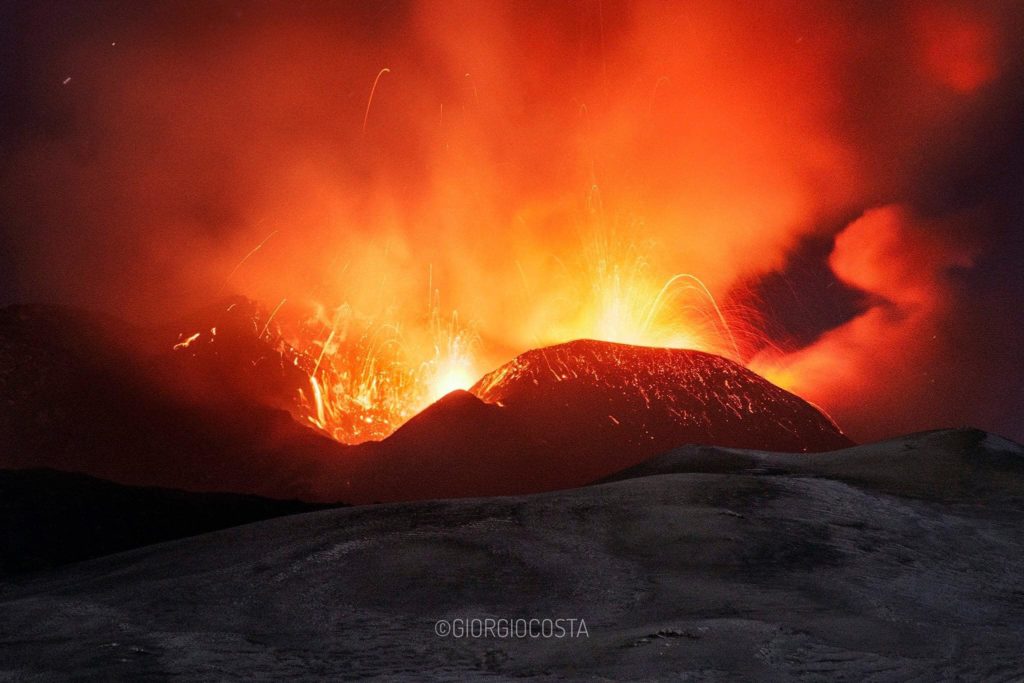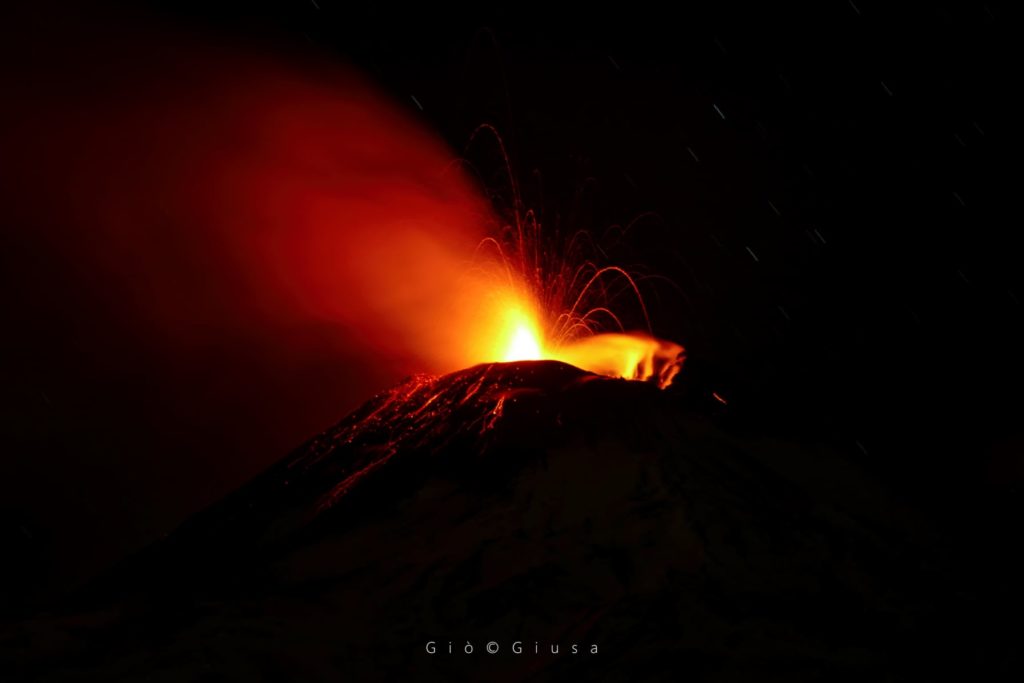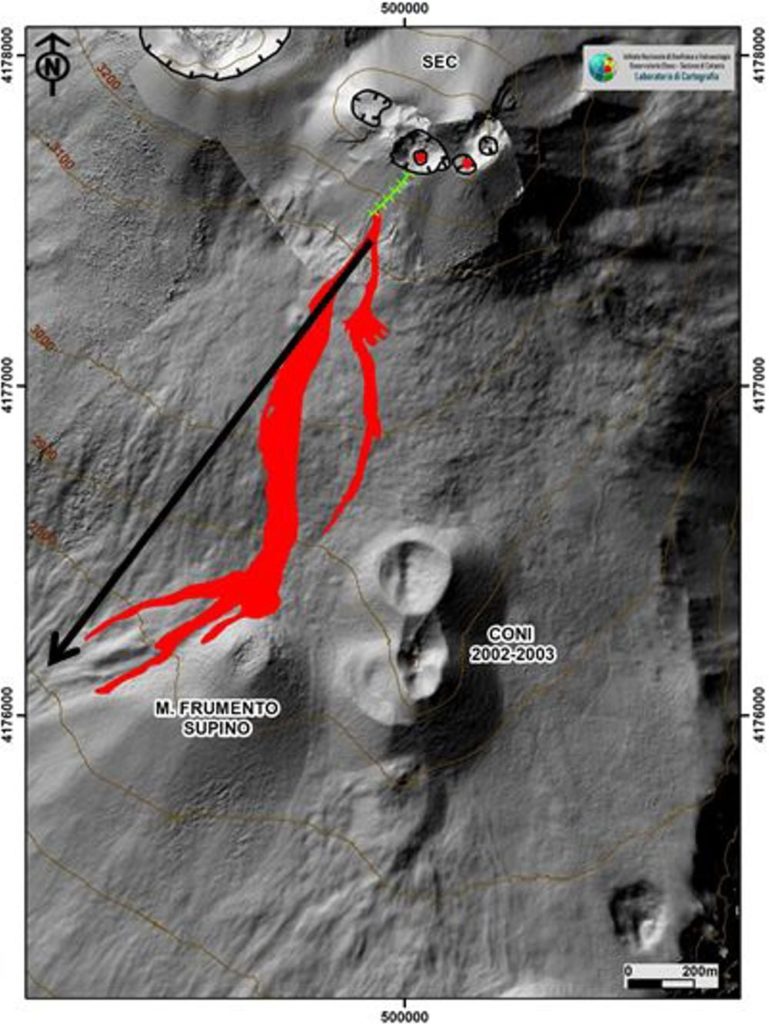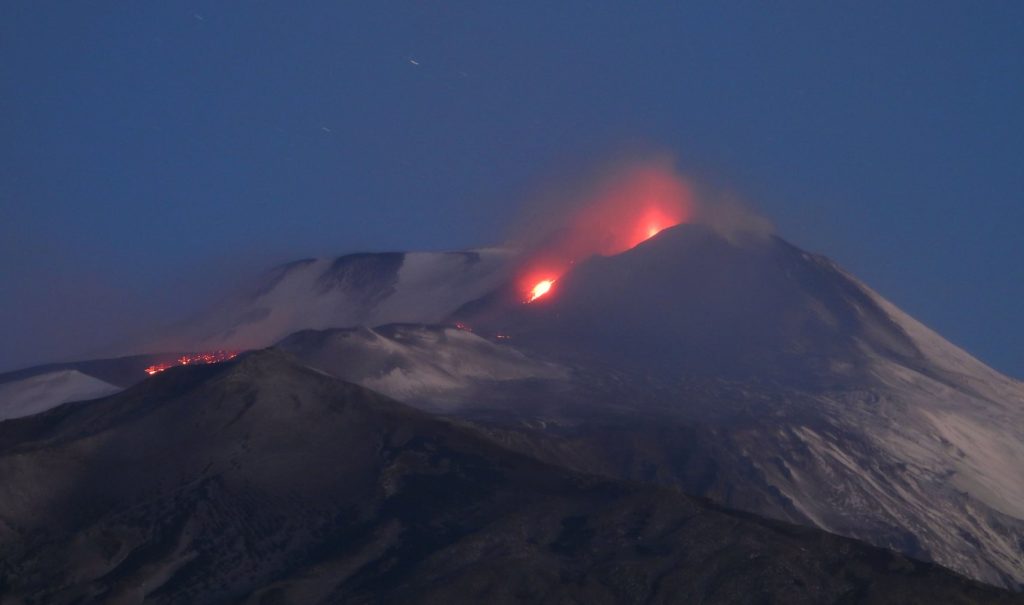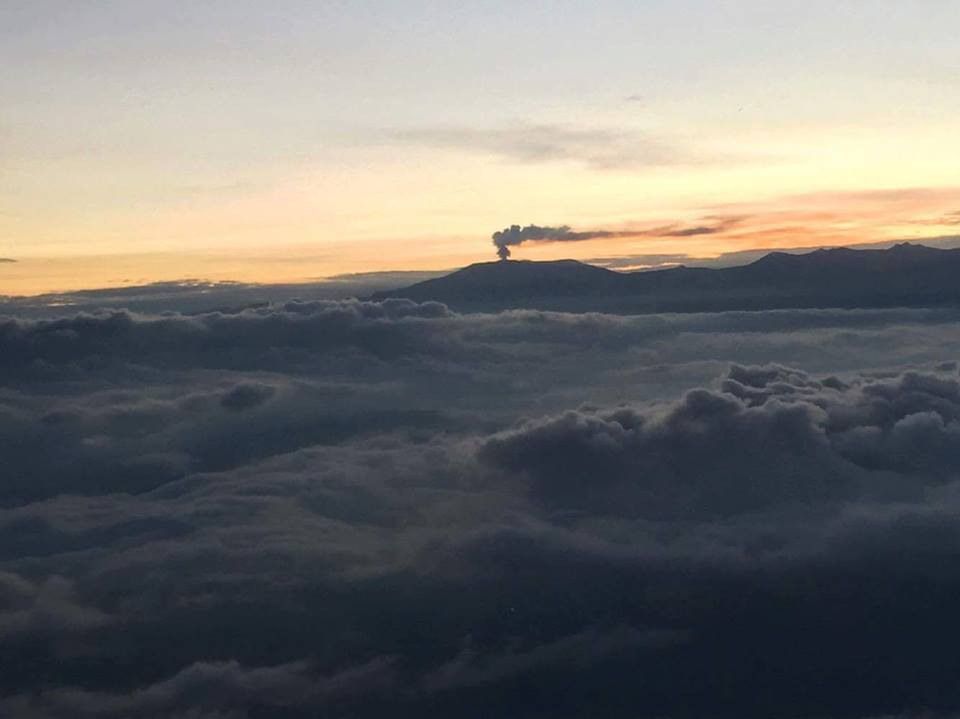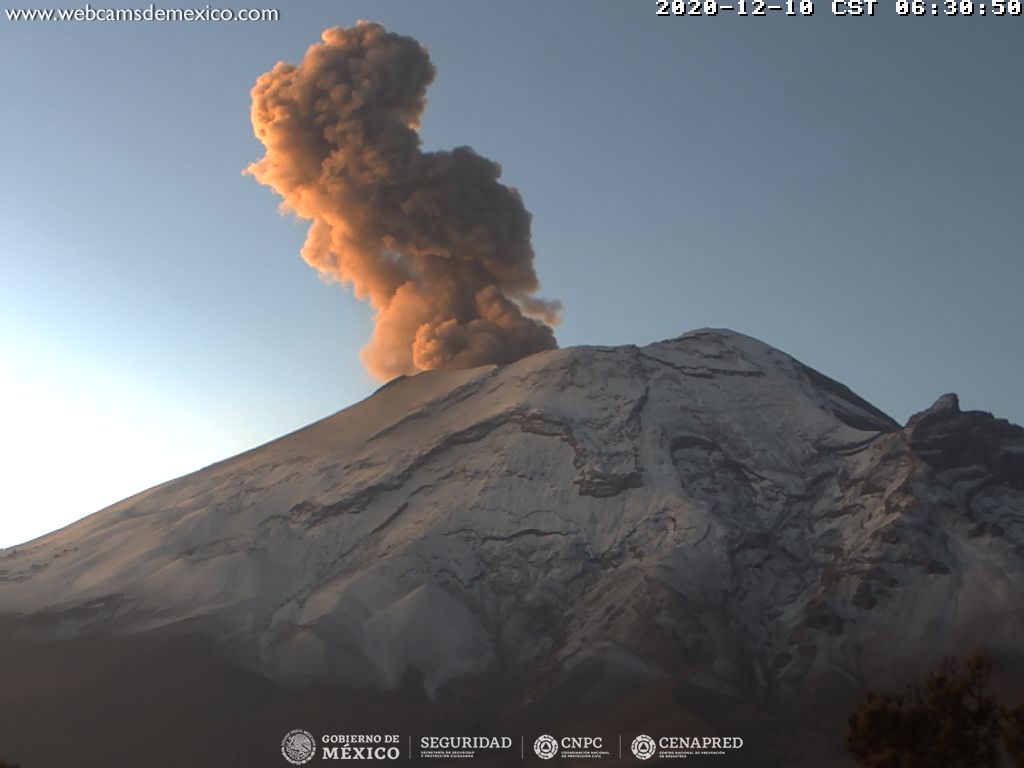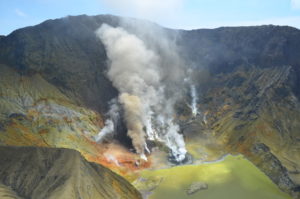December 16 , 2020.
Italy / Sicily , Etna :
ETNA PRESS RELEASE [UPDATE n. 97]
The National Institute of Geophysics and Volcanology, Osservatorio Etneo, announces that during the night, the eruptive activity of Etna has sharply decreased. From dawn, Strombolian activity is detected from three mouths of the Southeast crater: a mouth called: ‘della sella’, the other two in the eastern part of the cone. From approximately 06:30 UTC, there is a heavy emission of ash, which has formed a plume towards the south. In addition, sporadic explosions occur from the crater of Voragine which produce modest ash emissions; at night, the launch of glowing pyroclastic material was visible.
From 08:24 UTC, there is a resumption of the lava emission from the open landslide zone on the southwest flank of the southeast crater during the paroxysmal activity of December 13 in the evening, forming a lava flow directed towards the southwest.
From the seismic point of view, the volcanic tremor, during the last hours, showed an increase in its average amplitude from around 06:00 UTC, always staying at a high value. The position of the center of gravity of its sources of the tremor is always located in the area of the Southeast crater. The infrasonic activity continues to be sustained: the number and amplitude of infrasonic events remain at a high level, especially during the phases of increasing the amplitude of the tremors.
The GPS and inclinometric networks show no significant deformation in progress.
Weekly bulletin, from December 07, 2020 to December 13, 2020 (issue date December 15, 2020)
SUMMARY OF THE STATE OF ACTIVITY
In the light of surveillance data, it is highlighted:
1) VOLCANOLOGICAL OBSERVATIONS: Strombolian activity of variable intensity, episodes of lava fountains, volcanic ash emissions, effusive activity and formation of pyroclastic flows in the Southeast Crater. Strombolian activity within the deep crater at the Northeast crater and at the Bocca Nuova crater with rare and diluted ash emissions. Intermittent explosive activity at the Voragine crater with occasional and diluted ash emissions.
2) SEISMOLOGY: Seismic activity of moderate fracturing; The average amplitude of the volcanic tremor remained at average levels until December 13, then at high levels.
3) INFRASON: Low infrasound activity throughout the week; defended on December 14.
4) DEFORMATIONS: No significant change to report for the GNSS network.
The inclinometric network recorded a transient deformation of the order of a tenth of a microradian concomitant with the eruptive event of the 13th in the evening.
5) GEOCHEMISTRY: The flow of SO2: average level
HCl flux occurs at a medium-high level.
Soil CO2 flux shows a moderately decreasing trend, stabilizing at medium levels.
The partial pressure of dissolved CO2 does not show significant changes.
The value of the C / S ratio is at medium-low levels (last measurement dated 10/16/2020).
The isotope ratio of helium is at average values (last update 11/26/2020).
6) SATELLITE OBSERVATIONS: The thermal activity in the summit area is at a high level.
VOLCANOLOGICAL OBSERVATIONS
During the week, the monitoring of the volcanic activity of Etna was carried out by analyzing the images of the surveillance cameras of the INGV, Osservatorio Etneo (INGV-OE)
and by INGV-OE staff in the field on December 14. Due to adverse weather conditions, observation of volcanic activity by cameras was limited for most of the week.
In general, in the period when it was possible to investigate, from December 7 to 12, the activity of Etna had a behavior similar to the previous week (Rep. N ° 50/2020) with a Strombolian activity of variable intensity at the Southeast Crater (SEC) which produced occasional and modest ash emissions and the launching of lava shreds, as well as intra-crater Strombolian activity at the Northeast Crater (NEC) and the crater of the Bocca Nuova (BN) with very diluted rare ash emissions. In detail, Strombolian activity at the Southeast Crater (SEC) was variable in intensity and almost continuous at the East Vent with occasional splashes of lava over the vent and rolling of products along the walls of the SEC.. The more central mouth was characterized mainly by discontinuous activity and of less intensity. The rare and modest ash emissions were mainly produced by the activity of the eastern vent and quickly dispersed to the summit area. The eruptive activity of the Southeast Crater (SEC) intensified on December 13 and in particular from 19:20 UTC (all times shown are in UTC).
At around 10:00 p.m., Strombolian activity shifted to the lava fountains and at 10:15 p.m. a small pyroclastic flow was observed which spread from the southwest flank of the Southeast Crater (SEC) to the South-South West . By 10:16 p.m. this flow had already stopped and another, more energetic, was generated, which tracing the same path extended to about 2 km from the Southeast Crater (SEC) in ~ 40 s (~ 50 m s-1), abundantly surmounting Mount Frumento Supino to the west. At 10:30 p.m., a third smaller pyroclastic flow was observed, still expanding in a South-South-West direction). As confirmed by observations made in situ, on December 14 by INGV-OE personnel, the three pyroclastic flows were generated mainly due to the collapse of the southwestern part of the SEC cone (Fig. 1 ). Simultaneously, with the formation of the first two pyroclastic flows, two lava flows produced by two eruptive cracks open at the base of the SEC (South flow) and by its southwestern lower flank (Southwest lava flow) were observed (Fig. 1). The lava fountain ran out at ~ 10:50 p.m., but the explosive activity continued with great variability and then intensified, producing two more lava fountains, of lesser intensity and duration than the first, between 11:50 UTC December 13 and December 14 at 12:10 UTC and December 14 at 1:10 and 01:23 UTC.
During the fountain phases, the maximum values of the amplitude of the volcanic tremor were recorded.
Fig. 1 – Preliminary map of the lava field reproduced through observations from the ground, analysis of thermal, visible images and from the PlanetScope satellite, the black arrow indicates the probable direction of propagation of pyroclastic flows.
On December 14, during the inspection, the two lava flows were no longer fed and cooled. The southern flow had widened at the base of the SEC cone forming at least four main lobes which stopped on the plateau between the base of the SEC and the 2002-03 cones. One of these continued to extend south-southwest then stopped between the 2002-03 cones and Mt. Frumento Supino. The southwest lava flow had taken place following the same direction as the other lava flow, reaching and partially bypassing to the west Mount Frumento Supino, where its front had widened and thickened. From the in situ landforms, the southern flow appears considerably narrower than the other, especially near its front, while the southwest lava flow covered a much larger area from the proximal area to the mouth ( Fig. 1).
As for the explosive activity at the Southeast crater, it was on December 14 of very variable intensity, producing in the phases of decrease of the intra-crater explosions with rumblings and sporadic emissions of ash which quickly dispersed in the area. Summit. In the phases of increasing intensity, ash emissions were observed, the most visible at 12:52 p.m. produced by an explosive vent located in the eastern sector of the SEC, which formed an eruptive cloud which drifted in a southerly direction reaching an altitude maximum of ~ 4 km above sea level, and strombolian activity that continued with the launching of scraps of lava beyond the crater rim from at least two mouths.
During the week, the Northeast Crater (NEC) fueled intracrater Strombolian activity of varying intensity with rare emissions of dilute ash. The Bocca Nuova produced rare and diluted ash emissions and the discontinuous explosive activity of Voragine produced light ash emissions which were dispersed in the summit area.
ETNA COMMUNICATION [UPDATE n. 98]
The National Institute of Geophysics and Volcanology, Osservatorio Etneo, reports that the intense explosive activity of the three mouths of the Southeast Crater and the emission of the new lava flow continued until the end of the morning yesterday, and was followed by a rapid decrease. By late afternoon, activity in the Southeast Crater had practically ceased, while sporadic puffs of ash continued to be emitted from the Voragine and Bocca Nuova craters. In the evening, the front of the lava flow, around 2900 m, still showed incandescent spots. The lava flow, however, was no longer fueled.
From the seismic point of view, the volcanic tremor, in the last hours, showed a clear decrease in its average amplitude from around 10:00 UTC, currently returning to an average value. The position of the center of gravity of the sources of the tremor is always located in the area of the Southeast Crater. Infrasound activity also recorded a decrease in the number and extent of infrasonic events; the sources are mainly located in the area of the Southeast Crater, the Bocca Nuova Crater and the Northeast Crater.
No significant change is observed in the permanent soil deformation networks (inclinometric and GPS).
Further updates will be communicated shortly.
Source : INGV .
Photos : Giorgio Costa , Gio Giusa , INGV / Boris Behncke.
Italy , Stromboli :
Weekly bulletin, from December 07, 2020 to December 13, 2020 (issue date December 15, 2020)
SUMMARY OF THE STATE OF ACTIVITY
In the light of surveillance data, it is highlighted:
1) VOLCANOLOGICAL OBSERVATIONS: Normal explosive volcanic activity of Strombolian type at low levels (2-5 events / h) in the period from 6 to 10 December and at medium-low levels (6 to 8 events / h) in the period from 11 to December 13. The intensity was low both in the area of the north crater and in the Center-South zone .
2) SEISMOLOGY: The seismological parameters do not show significant variations.
3) DEFORMATIONS: No significant change recorded by tilt and GNSS networks
4) GEOCHEMISTRY: SO2 flux: medium-low
C / S Ratio – Latest values (C / S = 12.1) are average levels.
The isotopic ratio of He is at average values (R / Ra = 4.37 sampling of November 24).
5) SATELLITE OBSERVATIONS: The thermal activity in the summit area is at a low level.
VOLCANOLOGICAL OBSERVATIONS
In the period under observation, the eruptive activity of Stromboli was characterized by the analysis of the images recorded by the surveillance cameras INGV-OE located at 190 m, Punta Corvi and 400 m.
In the area of the North crater, the N1 crater, with two emission points, produced low intensity explosions (less than 80 m high) emitting fine materials (ash) mixed with coarse materials (lapilli and bombs) . The N2 mouth, at two points of emission, showed mainly a low intensity explosive activity emitting coarse matter mixed with fine materials. The average frequency of the explosions varied from 2 to 7 events / h.
In the Center-South zone, the explosions mainly emitted fine materials with medium intensity (the products reached 150 m in height). The explosive activity showed hourly frequency values between less than 1 and 2 events / h.
The amplitude of the volcanic tremor had medium-low values.
Source : INGV.
Photo : Webcam via Stromboli Adventures
Colombia , Nevado del Ruiz :
Nevado del Ruiz volcano activity level bulletin.
The activity level continues at Yellow Activity Level or (III): changes in the behavior of volcanic activity.
Regarding the monitoring of the activity of the Nevado del Ruiz volcano, the COLOMBIAN GEOLOGICAL SERVICE reports that:
The seismicity generated by rock fracturing decreased in the number of earthquakes and in the seismic energy released, compared to the previous week. This seismic activity was located mainly in the Arenas crater, to the South-East, to the East, to the North-East, to the South-South-West and, to a lesser extent, to the North of it, at depths varying from 0.1 to 6.9 km. The highest magnitude recorded during the week was 1.2 ML (local magnitude), which corresponds to the earthquake that occurred on December 8 in
10:40 p.m. (local time), located 4.7 km east of the Arenas crater, 3.6 km deep.
The seismicity linked to the dynamics of the fluids inside the volcanic conduits, decreased in the number of events and in the seismic energy released compared to the previous week. This seismic activity was characterized by the occurrence of continuous volcanic tremor, tremor pulses, long and very long period type earthquakes, which presented variable energy levels and spectral content.
During the week, there were several episodes of low energy « drumbeat » type seismicity associated with rock fracturing and fluid dynamics within the volcanic conduits. This seismicity has been linked to the processes of ascent, location-growth and evolution of a lava dome at the bottom of the Arenas crater of the Nevado del Ruiz volcano.
Over the past week, the MIROVA portal and Nasa Firms reported low-energy thermal anomalies over the volcano.
The Nevado del Ruiz volcano continues at the yellow activity level.
Source : SGC.
Photo : Diana M Bustamante.
Mexico , Popocatepetl :
December 15, 11:00 a.m. (December 15, 5:00 p.m. GMT)
During the past 24 hours, according to the monitoring systems of the Popocatépetl volcano, 182 exhalations have been identified, accompanied by emissions of volcanic gases and light amounts of ash. In addition, an additional 52 minutes of low amplitude tremor were recorded.
Since this morning and at the time of this report, an intermittent emission of water vapor and gas has been observed with a northeast direction.
CENAPRED urges NOT TO APPROACH the volcano and in particular the crater, because of the danger posed by the fall of ballistic fragments and, in the event of heavy rains, to stay away from the bottom of the ravines because of the danger of flows. mud and debris.
The Popocatépetl volcanic alert semaphore is in YELLOW PHASE 2.
Source : Cenapred .
Photo : Webcamdemexico ( archive).


